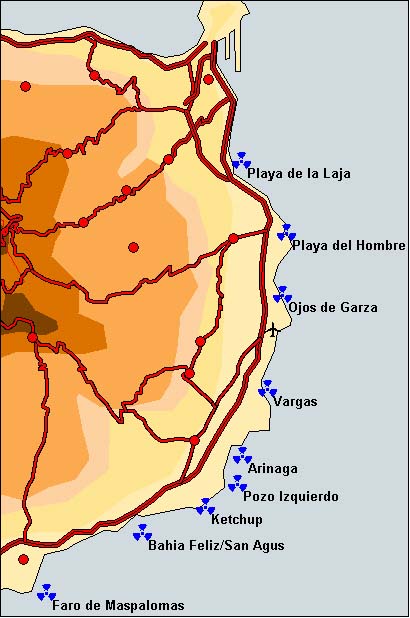


Click on the map to get a detailed description of the sailing spot.
Useful links:
-
10-day weather forecast (no wind..)
-
Cutre surfshop at Pozo Izquierdo (Webcams for Pozo)
-
These pages were created for noncommercial purposes. All images and maps by author.Any comments, corrections and suggestions are welcome. My email address is markus.huhtinen@ncp.fi.
Gran Canaria is probably one of the windiest places on earth. The normally moderate northeastern trade winds accelerate on the east coast of the mountainous island. Local windspeeds of 30-50 kts are regularly recorded at popular windsurfing spots along the coast.
Sailable wind blows somewhere along the east coast just about every day, but finding the windiest spot is not always simple. Due to the spherical form of the island, the location of the wind line keeps moving according to the wind direction. Some 10 degree windshift to the north may leave 10 kms of the coastline bathing in the sunshine with light thermal breeze, while 30 knot winds keep blowing just 15 minutes drive away
In general, as the wind turns north, the further north you have to drive to meet it. The sea may look dead calm, the wind may be whistling just around the next rocky point.
Strange as it may be, the strongest wind is usually found just few kilometers after the wind line. Drive further than necessary, and you will find calmer beaches again. Of course, this is often desirable if 50-knots wind at Pozo is just too much. So be prepared to drive and do some wind searching. It will pay.
Seasonal change
Summer is the windiest season, and one can expect almost continuous 20-50 kts winds at the southeastern sailing spots. The high pressure center of the Azores pretty much stays where it should, cooling the southeastern part of the island with more wind than most of us would prefer. Normal summer sail sizes in Pozo are 3.3-5.0 m2.
During the winter the prevailing trade wind pattern is affected by the low pressure areas approaching the island from the west. As the lows get closer, the northeasterly tradewinds give way to sometimes stormy soutwesterly winds accompanied with occasional heavy rains. Normally the weather pattern stabilizes again after few days. The usual winter tradewind windspeeds vary between 10 and 30 kts. Standard winter sail sizes for wavesailing are 4.2-5.5 m2.
It is not uncommon to have a week of light-to-moderate winds during the winter months. If you want to sail every day, bring some light wind gear with you. Big sails are difficult to find from the rental shops.
Water temperatures can get as low as 17-18 C in January-February, so short-armed steamer may be a good choice. A shorty is enough for the rest of the year. The southern part of the island gets more hours of sunshine, and the temperatures are generally higher.
Security
One should never underestimate the conditions. The wind usually blows stronger than it appears, and sea state may be much rougher than expected. After all, it is an ocean out there.
Remember that you're on an island. There is no next beach to welcome you if something goes wrong. Instead, there is a nasty current sucking you fast towards Brazil. Please, do not test the ability of the local coast guard and the functionality of their thermal cameras. Their record of finding drifting windsurfers after sunset is not very good.
Launches
I have marked on the map some of the most popular windsurfing spots along the east coast. Just click on the name to get the detailed map and my very subjective impression of the spot. There are also images of some spots.
Northern and northeastern beaches are exposed to the ocean swell which may make launching difficult if not impossible. Even if the wind is good, the shorebreak may nil your changes to get out in one piece. Especially sailors who like to sail big FW gear may find themeselves in a tricky situation between possibly destroyed gear and a good training day.
If strong southerlies blow more than a day, the southern coast may also become unaccessible due to heavy shorebreak. So study your tables for low tide or try beaches in the north. Better still, stick to golf. It is probably a cheaper alternative to trashing your gear and ego.
